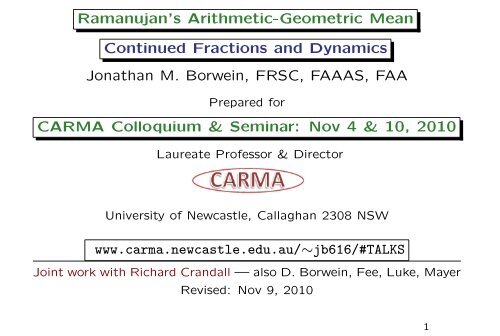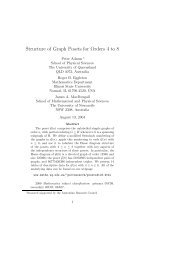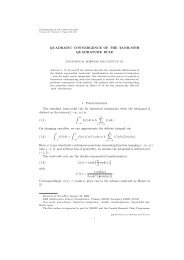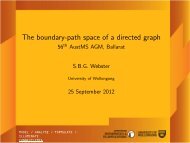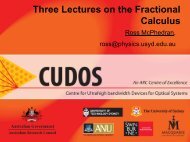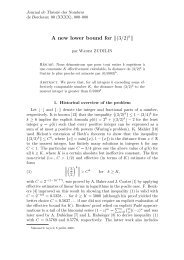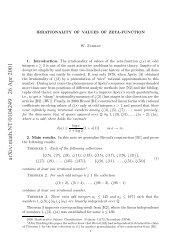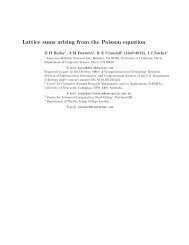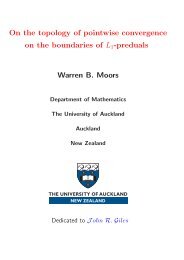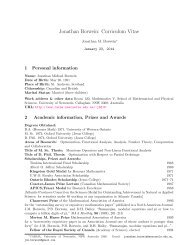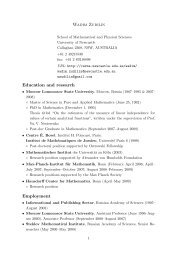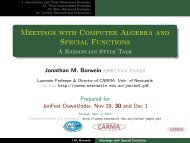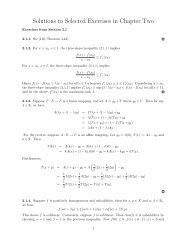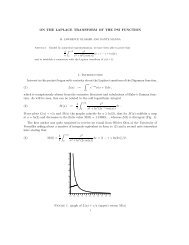Ramanujan's Arithmetic-Geometric Mean Continued Fractions and ...
Ramanujan's Arithmetic-Geometric Mean Continued Fractions and ...
Ramanujan's Arithmetic-Geometric Mean Continued Fractions and ...
Create successful ePaper yourself
Turn your PDF publications into a flip-book with our unique Google optimized e-Paper software.
Ramanujan’s <strong>Arithmetic</strong>-<strong>Geometric</strong> <strong>Mean</strong><br />
<strong>Continued</strong> <strong>Fractions</strong> <strong>and</strong> Dynamics<br />
Jonathan M. Borwein, FRSC, FAAAS, FAA<br />
Prepared for<br />
CARMA Colloquium & Seminar: Nov 4 & 10, 2010<br />
Laureate Professor & Director<br />
University of Newcastle, Callaghan 2308 NSW<br />
www.carma.newcastle.edu.au/∼jb616/#TALKS<br />
Joint work with Richard Cr<strong>and</strong>all — also D. Borwein, Fee, Luke, Mayer<br />
Revised: Nov 9, 2010<br />
1
About Verbal Presentations<br />
I feel so strongly about the wrongness of reading<br />
a lecture that my language may seem immoderate.<br />
· · · The spoken word <strong>and</strong> the written word are quite<br />
different arts. · · · I feel that to collect an audience<br />
<strong>and</strong> then read one’s material is like inviting a friend<br />
to go for a walk <strong>and</strong> asking him not to mind if you<br />
go alongside him in your car. ∗ — Sir Lawrence<br />
Bragg<br />
• What would he say about reading overheads?<br />
∗ From page 76 of Science, July 5, 1996.<br />
2
Srinivasa Ramanujan (1887–1920)<br />
• G. N. Watson (1886–1965), on reading Ramanujan’s<br />
work, describes:<br />
3
a thrill which is indistinguishable from the thrill I<br />
feel when I enter the Sagrestia Nuovo of the Capella<br />
Medici <strong>and</strong> see before me the austere beauty of the<br />
four statues representing ‘Day,’ ‘Night,’ ‘Evening,’<br />
<strong>and</strong> ‘Dawn’ which Michelangelo has set over the<br />
tomb of Guiliano de’Medici <strong>and</strong> Lorenzo de’Medici.<br />
4
1. Abstract<br />
The Ramanujan AGM continued fraction<br />
R η (a, b) =<br />
η +<br />
η +<br />
a<br />
b 2<br />
η +<br />
4a 2<br />
9b2<br />
η + ...<br />
enjoys attractive algebraic properties such as a striking<br />
arithmetic-geometric mean relation & elegant links with<br />
elliptic-function theory.<br />
5
• The fraction presented a serious computational challenge,<br />
which we could not resist.<br />
♣ Resolving this challenge lead to four quite subtle published<br />
papers:<br />
– two published in Experimental Mathematics 13 (2004),<br />
275–286, 287–296 <strong>and</strong>;<br />
– two in The Ramanujan Journal 13, (2007), 63–101<br />
<strong>and</strong> 16 (2008), 285–304.<br />
6
In Part I (colloquium): we show how to rapidly evaluate<br />
R for any positive reals a, b, η. The problematic case being<br />
a ≈ b—then subtle transformations allow rapid evaluation.<br />
• On route we find, e.g., that for rational a = b, R η is an<br />
L-series with a ’closed-form.’<br />
• We ultimately exhibit an algorithm yielding D digits<br />
of R in O(D) iterations. ∗<br />
In Part II (seminar): we address the harder theoretical<br />
<strong>and</strong> computational dilemmas arising when (i) parameters<br />
are allowed to be complex, or (ii) more general fractions<br />
are used.<br />
∗ The big-O constant is independent of the positive-real triple a, b, η.<br />
7
2. Preliminaries<br />
PART I. Entry 12 of Chapter 18 of Ramanujan’s Second<br />
Notebook [BeIII] gives the beautiful:<br />
R η (a, b) =<br />
η +<br />
η +<br />
a<br />
b 2<br />
4a 2<br />
η +<br />
9b2<br />
η + ...<br />
(1.1)<br />
which we interpret—in most of the present treatment—for<br />
real, positive a, b, η > 0.<br />
8
Remarkably, for such parameters, R satisfies an AGM relation:<br />
( a + b<br />
R η<br />
2 , √ )<br />
ab = R η(a, b) + R η (b, a)<br />
(1.2)<br />
2<br />
1. (1.2) is one of many relations we develop for computation of R η .<br />
2. The hard cases occur when b is near to a, including the case<br />
a = b.<br />
3. We eventually exhibit an algorithm uniformly of geometric/linear<br />
convergence across the positive quadrant a, b > 0.<br />
4. Along the way, we find attractive identities, such as that for<br />
R η (r, r), with r rational.<br />
5. Finally, we consider complex a, b—obtaining theorems <strong>and</strong> conjectures<br />
on the domain of validity for the AGM relation (1.2).<br />
9
Research started in earnest when we noted<br />
R 1 (1, 1) ‘seemed close to’ log 2.<br />
Such is the value of experiment:<br />
one can be led into deep waters.<br />
As can be seen by ‘cancellation’ of the η<br />
elements down the fraction:<br />
R η (a, b) = R 1 (a/η, b/η),<br />
valid because the fraction converges.<br />
Discussed in Ch. 1 of Experimentation<br />
in Mathematics.<br />
10
To prove convergence we put a/R 1 in RCF (reduced continued<br />
fraction) form:<br />
R 1 (a, b) =<br />
a<br />
[A 0 ; A 1 , A 2 , A 3 , . . . ]<br />
(2.1)<br />
:=<br />
A 0 +<br />
A 1 +<br />
a<br />
1<br />
A 2 +<br />
1<br />
1<br />
A 3 + ...<br />
where the A i are all positive real.<br />
11
It is here [Ramanujan’s<br />
work on<br />
elliptic <strong>and</strong> modular<br />
functions] that<br />
both the profundity<br />
<strong>and</strong> limitations of<br />
Ramanujan’s knowledge<br />
st<strong>and</strong> out most<br />
sharply.<br />
— G.H. Hardy<br />
12
Inspection of R yields the RCF elements explicitly <strong>and</strong> gives<br />
the asymptotics of A n :<br />
For even n<br />
A n = n!2 bn<br />
4−n<br />
(n/2)! 4 a n ∼ 2<br />
π n<br />
b n<br />
a n.<br />
For odd n<br />
A n =<br />
((n − 1)/2!)4<br />
n! 2 4<br />
n−1 an−1<br />
b n+1 ∼ π<br />
2 ab n<br />
a n<br />
b n . 13
• This representation leads immediately to:<br />
Theorem 2.1: For any positive real pair a, b the fraction<br />
R 1 (a, b) converges.<br />
Proof: An RCF converges iff ∑ A i diverges. (This is the<br />
Seidel–Stern theorem [Kh,LW].)<br />
In our case, such divergence is evident for every choice of<br />
real a, b > 0.<br />
c⃝<br />
We later show a different fraction for R(a), <strong>and</strong> other computationally<br />
efficient constructs.<br />
14
• Note for a = b, divergence of ∑ A i is only logarithmic<br />
— a true indication of slow convergence (we wax more<br />
quantitatively later).<br />
• Our interest started with asking how, for a > 0, to<br />
(rapidly) evaluate<br />
R(a) := R 1 (a, a)<br />
<strong>and</strong> thence to prove suspected identities.<br />
15
3. Hyperbolic-elliptic Forms<br />
Links between st<strong>and</strong>ard Jacobi theta functions<br />
θ 2 (q) := ∑ q (n+1/2)2 ,<br />
θ 3 (q) := ∑ q n2<br />
<strong>and</strong> elliptic integrals yield various results. We start with:<br />
Theorem 3.1: For real y, η > 0 <strong>and</strong> q := e −πy<br />
η ∑<br />
k∈D<br />
η ∑<br />
k∈E<br />
sech(kπy/2)<br />
η 2 + k 2<br />
sech(kπy/2)<br />
η 2 + k 2<br />
= R η (θ 2 2 (q), θ2 3 (q)),<br />
= R η (θ 2 3 (q), θ2 2 (q)),<br />
where D, E denote respectively the odd, even integers.<br />
Consequently, the Ramanujan AGM identity (1.2) holds<br />
for positive triples η, a, b.<br />
17
Proof: The sech relations are proved—in equivalent form—<br />
in Berndt’s treatment (Vol II, Ch. 18) of Ramanujan’s<br />
Notebooks [BeIII].<br />
For the AGM, assume 0 < b < a. The assignments<br />
θ2 2 (q)/θ2 3 (q) := b/a, η := θ2 2 (q)/b<br />
are possible (since b/a ∈ [0, 1), see [BB]) <strong>and</strong> implicitly<br />
define q, η, <strong>and</strong> together with<br />
θ 2 2 (q) + θ2 3 (q) = θ2 3 (√ q),<br />
2 θ 2 (q)θ 3 (q) = θ 2 2 (√ q)<br />
<strong>and</strong> repeated use of the sech sums above yield<br />
R 1<br />
(<br />
θ<br />
2<br />
3 (q)/η, θ 2 2 (q)/η) + R 1<br />
(<br />
θ<br />
2<br />
2 (q)/η, θ 2 3 (q)/η)<br />
= 2R 1<br />
(<br />
θ<br />
2<br />
3 ( √ q)/(2η), θ 2 2 (√ q)/(2η) ) .<br />
18
Since<br />
θ2 2 (q) = η b, θ2<br />
3 (q) = η a<br />
the AGM identity (1.2) holds for all pairs with a > b > 0.<br />
The case 0 < a < b is h<strong>and</strong>led by symmetry, or on starting<br />
by setting θ2 2(q)/θ2 3<br />
(q) := a/b.<br />
c⃝<br />
• The wonderful sech identities above stem from classical<br />
work of Rogers, Stieltjes, Preece, <strong>and</strong> of course<br />
Ramanujan [BeIII] in which one finds the earlier work<br />
detailed.<br />
• The proof given for the AGM identity has been claimed<br />
for various complex a, b sometimes over ambitiously. ∗<br />
∗ Mea culpa indirectly.<br />
19
• These sech series can be used to establish two numerical<br />
series involving the complete elliptic integral<br />
K(k) :=<br />
∫ π/2<br />
0<br />
1<br />
√<br />
dθ.<br />
1 − k 2 sin 2 (θ)<br />
We write K := K(k), K ′ := K(k ′ ) with k ′ :=<br />
Theorem 3.2: For 0 < b < a <strong>and</strong> k := b/a we have<br />
R 1 (a, b) = πa K<br />
2<br />
∑<br />
n∈Z<br />
)<br />
√<br />
1 − k 2 . ∗<br />
sech ( nπ K′<br />
K<br />
K 2 + π 2 a 2 n2. (3.1)<br />
Correspondingly, for 0 < a < b <strong>and</strong> k := a/b we have<br />
R 1 (a, b) = 2πb K ∑<br />
n∈D<br />
∗ K(k) is fast computable via the AGM iteration.<br />
)<br />
sech ( nπ2K<br />
K′<br />
4K 2 + π 2 b 2 n2. (3.2)<br />
20
Proof: The series follow from the assignments<br />
θ3 2 (q)/η := max(a, b), θ2 2 (q)/η := min(a, b)<br />
<strong>and</strong> Jacobi’s nome relations<br />
e −πK′ /K = q,<br />
K(k) = π 2 θ2 3 (q)<br />
inserted appropriately into Theorem 3.1.<br />
c⃝<br />
• The sech-elliptic series (3.1-2) allow fast computation<br />
of R 1 for b not too near a.<br />
• D digits for R 1 (a, b) requires O(D K/K ′ ) summ<strong>and</strong>s.<br />
• So, another motive for the following analysis was slow<br />
convergence of the sech-elliptic forms for b ≈ a.<br />
21
• We also have attractive evaluations such as<br />
R 1<br />
(1,<br />
)<br />
1<br />
√<br />
2<br />
= π ( )<br />
1<br />
2 K √2<br />
∑<br />
n∈Z<br />
sech(nπ)<br />
K 2 (1/ √ 2) + n 2 π 2.<br />
Here<br />
see [BB].<br />
K<br />
( )<br />
1<br />
√2<br />
= Γ2 (1/4)<br />
4 √ π ,<br />
• There are similar series for R 1 (1, k N ) at the N-th singular<br />
value, [BBa2].<br />
22
• A similar relation for R 1<br />
(<br />
1/<br />
√<br />
2, 1<br />
)<br />
obtains via (3.2),<br />
<strong>and</strong> via the AGM relation (1.2) yields the oddity:<br />
R 1<br />
(<br />
1 +<br />
√<br />
2<br />
2 √ 2 , 1<br />
2 1/4 )<br />
= π K<br />
( )<br />
1<br />
√2<br />
∑<br />
n∈Z<br />
sech(nπ/2)<br />
4K 2 (1/ √ 2) + n 2 π 2.<br />
• But we have no closed forms for a ≠ b.<br />
23
4. Six Forms for R(a)<br />
• Recalling that R(a) := R 1 (a, a), we next derive relations<br />
for the hard case b = a.<br />
Interpreting (3.1) as a Riemann-integral in the limit as<br />
b → a − (for a > 0), gives a slew of relations involving<br />
the digamma function [St,AS] ψ := Γ′<br />
Γ<br />
<strong>and</strong> the Gaussian<br />
hypergeometric function<br />
F = 2 F 1 (a, b; c; ·).<br />
• The following identities are presented in an order that<br />
can be serially derived:<br />
24
Evaluating R(a)<br />
Proposition: For all a > 0:<br />
R(a) =<br />
∫ ∞<br />
0<br />
= 2 a<br />
= 1 2<br />
)<br />
sech ( π x<br />
2 a<br />
1 + x 2 dx<br />
∞∑<br />
( k=1<br />
ψ<br />
(−1) k+1<br />
1 + (2 k − 1) a<br />
( 3<br />
4 4a)<br />
+ 1 ( 1<br />
− ψ<br />
4 4a))<br />
+ 1<br />
= 2a<br />
1 + a F ( 1<br />
2a + 1 2 , 1; 1 2a + 3 2 ; −1 )<br />
= 2<br />
=<br />
∫ 1<br />
∫<br />
0<br />
∞<br />
t 1/a<br />
1 + t 2 dt<br />
0 e−x/a sech(x) dx.<br />
25
Exploiting the Various Forms<br />
The first series or t-integral yield a recurrence<br />
R(a) =<br />
2a ( )<br />
1 + a − R a<br />
,<br />
1 + 2a<br />
while known relations for digamma [AS,St] lead to<br />
R(a) = C(a) + π 2 sec ( π<br />
2a<br />
)<br />
− (4.1)<br />
2a 2 (1 + 8a − 106a 2 + 280a 3 + 9a 4 )<br />
1 − 12a + 25a 2 + 120a 3 − 341a 4 − 108a 5 + 315a 6<br />
for a “rational-zeta” series [BBC]:<br />
C(a) = 1 2<br />
∑<br />
n≥1<br />
{ζ(2n + 1) − 1} (3a − 1)2n − (a − 1) 2n<br />
(4a) 2n 26
• Note that (4.1), while rapidly convergent for some a,<br />
has sec poles, some being cancelled by the rational<br />
function.<br />
– We require a > 1/9 for convergence of the rationalzeta<br />
sum.<br />
– However, the recurrence relation above can be used<br />
to force convergence of such a rational-zeta series.<br />
27
• The hypergeometric form for R(a) is of special interest<br />
because [BBa1] of:<br />
The Gauss continued fraction<br />
F (γ, 1; 1 + γ; −1) = [α 1 , α 2 , · · · , α n , · · · ] (4.2)<br />
=<br />
α 1 +<br />
α 2 +<br />
1<br />
1<br />
α 3 +<br />
1<br />
1<br />
α 4 + ...<br />
28
Here, we have explicitly α 1 = 1 <strong>and</strong><br />
α n = γ ((n − 1)/2)!) −2 (n − 1 + γ)<br />
(n−3)/2<br />
∏<br />
j=1<br />
(j + γ) 2<br />
n = 3, 5, 7, . . .<br />
α n = γ −1 (n/2 − 1)! 2 (n − 1 + γ)<br />
n/2−1<br />
∏<br />
j=1<br />
(j + γ) −2<br />
n = 2, 4, 6, . . .<br />
29
Asymptotic Expansions need not Converge<br />
An interesting aspect of formal analysis is based upon the<br />
first sech-integral for R(a). Exp<strong>and</strong>ing <strong>and</strong> using a representation<br />
of the even Euler numbers<br />
one obtains<br />
E 2n := (−1) n ∫ ∞<br />
0 sech(πx/2)x2n dx<br />
R(a) ∼ ∑ n≥0<br />
E 2n a 2n+1 ,<br />
yielding an asymptotic series of zero radius of convergence.<br />
Here the E 2n commence<br />
1, −1, 5, −61, 1385, −50521, 2702765 . . .<br />
30
Moreover, for the asymptotic error, we have [BBa2,BCP]:<br />
∣<br />
∣<br />
N−1<br />
∣∣∣∣∣ R(a) − ∑<br />
E 2n a 2n+1 ≤ |E 2N | a 2N+1 ,<br />
∣<br />
n=1<br />
• It is a classic theorem of Borel [St,BBa2] that for every<br />
real sequence (a n ) there is a C ∞ function f on R with<br />
f (n) (0) = a n .<br />
• Who knew they could be so explicit?<br />
31
• The oft-stated success of Padé approximation is well<br />
exemplified in our case.<br />
If one takes the unique (3, 3) Padé form ∗ we obtain<br />
R(a) ≈ a 1 + 90 a2 + 1433 a 4 + 2304 a 6<br />
1 + 91 a 2 + 1519 a 4 + 3429 a 6.<br />
• This is remarkably good for small a; e.g., yielding<br />
R(1/10) ≈ 0.09904494 correct to the implied precision.<br />
For R(1/2) <strong>and</strong> the (30, 30) Padé approximant † one<br />
obtains 4 good digits.<br />
∗ Thus, top <strong>and</strong> bottom of R(a)/a have degree 3 in the variable a 2 .<br />
† Numerator <strong>and</strong> denominator have degree 30 in a 2 .<br />
32
• Though the convergence rate is slower for larger a, the<br />
method allows, say, graphing R to reasonable precision.<br />
A plot of R<br />
Having noted a formal expansion at a = 0, we naturally<br />
asked for: An asymptotic form valid for large a?<br />
• Via a typical asymptotic development, we find more,<br />
namely a convergent expansion for all a > 1:<br />
33
Starting with our second sech integral<br />
∫ ∞<br />
R(a) =<br />
0 e−x/a sech x dx<br />
we again use the Euler numbers <strong>and</strong> known Hurwitz-zeta<br />
evaluations of sech-power integrals for odd powers. We<br />
obtain a convergent series valid at least for real a > 1:<br />
R(a) = π ( ) π<br />
2 sec − 2 ∑ β(m + 1)<br />
2a<br />
m∈D + a m<br />
= 2 ∑ (<br />
β(k + 1) − 1 ) k<br />
a<br />
k≥0<br />
Here D + denotes positive odd integers <strong>and</strong><br />
β(s) := 1/1 s − 1/3 s + 1/5 s − · · ·<br />
is the Catalan primitive L-series mod 4.<br />
34
• Remarkably, we find the leading terms for large a involve<br />
Catalan’s constant G := β(2) via<br />
R(a) = π 2 − 2G a +<br />
π3<br />
16a 2 − · · ·,<br />
a development difficult to infer from casual inspection<br />
of Ramanujan’s fraction.<br />
• Even the asymptote R(∞) = π/2 is hard to so infer,<br />
though it follows from various of the previous representations<br />
for R(a). Using recurrence relations <strong>and</strong><br />
various expansions we also obtain results pertaining to<br />
the derivatives of R, notably<br />
)<br />
= π2<br />
(<br />
R ′ (1) = 8(1 − G), R ′ 1<br />
2 24 . 35
• A peculiar property of ψ leads to an exact evaluation<br />
of the imaginary part of the digamma representation<br />
of R(a) when a lies on the circle<br />
in the complex plane.<br />
C 1/2 := {z : |z − 1 2 | = 1 2 }<br />
Imaginary parts of the needed digamma values have a<br />
closed form [AS,St], <strong>and</strong> we obtain<br />
for<br />
Im(R(a)) = π 2 cosech ( πy<br />
2<br />
y := i<br />
(<br />
1 − 1 )<br />
a<br />
)<br />
− 1 y<br />
<strong>and</strong> a ∈ C 1/2 .<br />
36
• Note that y is always real, <strong>and</strong> we have an elementary<br />
form for Im(R) on the given continuum set. Admittedly<br />
we have not yet discussed complex parameters; we do<br />
that later.<br />
• The Ramanujan fraction converges at least for a =<br />
b, Re(a) ≠ 0, <strong>and</strong> it is instructive to compare numerical<br />
evaluations of imaginary parts via the above cosech<br />
identity.<br />
Firmament — made for Coxeter at ninety<br />
37
5. The R Function at Rational Arguments<br />
For positive integers p, q, we have from the above<br />
( ) (<br />
p 1<br />
R = 2p<br />
q q + p − 1<br />
q + 3p + 1<br />
)<br />
q + 5p − . . . ,<br />
which is in the form of a Dirichlet L-function. One way to<br />
evaluate L-functions is via Fourier-transforms to pick out<br />
terms from a general logarithmic series. An equivalent,<br />
elementary form for the digamma at rational arguments is<br />
a celebrated result of Gauss. In our case<br />
( )<br />
p<br />
q<br />
⎧<br />
⎨<br />
R<br />
=<br />
4p ∑<br />
odd k>0<br />
⎩ − log ( 1 − e 2πi k/(4p)) − 1 n<br />
e −2πi k(q+p)/(4p) ×<br />
q+p−1 ∑<br />
n=1<br />
e 2πi kn/(4p) ⎫<br />
⎬<br />
⎭ . 38
After various simplifications, forcing everything to be realvalued,<br />
we arrive at a finite closed form. Namely:<br />
R<br />
( p<br />
q)<br />
= −2p<br />
− 2<br />
+ 2π<br />
p+q−1<br />
∑<br />
n=1<br />
∑<br />
1 ( )<br />
δn≡p+q mod 4p − δ n≡3p+q mod 4p<br />
n<br />
0
Exact Evaluations<br />
R(1/4) = π 2 − 4 , R(1/3) = 1 − log 2,<br />
3<br />
R(1) = log 2, R(1/2) = 2 − π/2,<br />
R(2/3) = 4 − π √<br />
2<br />
− √ 2 log(1 + √ 2),<br />
R(3/2) = π + √ 3 log (2 − √ 3),<br />
R(2) = √ { π<br />
2<br />
2 − log(1 + √ }<br />
2) ,<br />
R(3) = π √<br />
3<br />
− log 2,<br />
40
• And, of course, many other attractive forms.<br />
• From (5.1) for positive integer q one has<br />
R(1/q) = rational + (−1) (q−1)/2 log 2<br />
(q odd)<br />
R(1/q) = rational + (−1) q/2 π/2<br />
(q even)<br />
as also follow from R(1) = log 2, R(1/2) = 2−π/2 <strong>and</strong><br />
( )<br />
1<br />
R = 2<br />
( )<br />
1<br />
q q − 1 − R .<br />
q − 2<br />
• An alluring evaluation involves the golden mean:<br />
R(5) = √<br />
π<br />
τ √ + log 2 − √ 5 log τ, (τ := (1+ √ 5)/2).<br />
5<br />
41
• Such evaluations—based on (5.1)—can involve quite<br />
delicate symbolic work.<br />
• We have not analyzed evaluating R(a) for irrational a<br />
by approximating a first via high-resolution rationals,<br />
<strong>and</strong> then using (5.1).<br />
Such a development would be of both computational<br />
<strong>and</strong> theoretical interest.<br />
42
• Armed with exact knowledge of R(p/q) we find some<br />
interesting Gauss-fraction results, in the form of rational<br />
multiples of<br />
F (γ, 1; 1 + γ; −1) = [α 1 , α 2 , . . . ].<br />
For example, (4.2) yields<br />
R(1) = log 2 =<br />
1 +<br />
1<br />
1<br />
1<br />
2 +<br />
3 + 1<br />
1 + ...<br />
,<br />
43
But alas the beginnings of this fraction are misleading;<br />
subsequent elements a n run<br />
log 2 = [1, 2, 3, 1, 5, 2 3 , 7, 1 2 , 9, 2 5 , . . . ],<br />
being as α n = n, 4/n resp. for n odd, even.<br />
Similarly, one can derive<br />
2 − 2 log 2 = [1 3 , r 2 , 2 3 , r 4 , 3 3 , r 6 , 4 3 , . . . ],<br />
are com-<br />
where the even-indexed fraction elements r 2n<br />
putable rationals.<br />
• Though these RCFs do not have integer elements, the<br />
growths of the α n provide a clue to the convergence<br />
rate, which we study in a subsequent section.<br />
44
6. Transformation of R 1 (a, b)<br />
The big step. We noted that the sech-elliptic series (3.1)<br />
(also (3.2)) will converge slowly when b ≈ a, yet in<br />
Sections 4, 5 we successfully addressed the case b = a.<br />
We now establish a series representation when b < a<br />
but b is very near to a.<br />
We employ the wonderful fact that sech is its own Fourier<br />
transform, in that<br />
∫ ∞<br />
−∞ ei γx sech(λx) dx = π λ sech ( πγ<br />
2λ<br />
)<br />
.<br />
46
Using this relation, one can perform a Poisson transform<br />
of the sech-elliptic series (3.1).<br />
• The success of the transform depends on analyzing<br />
I(λ, γ) :=<br />
∫ ∞<br />
−∞<br />
sechλx<br />
1 + x 2 ei γx dx.<br />
One may obtain the differential equation:<br />
− ∂2 I<br />
∂γ 2 + I = π ( ) πγ<br />
λ sech 2λ<br />
<strong>and</strong> solve it — after some machinations.<br />
47
We obtained<br />
I(λ, γ) = π<br />
cos λ e−γ + 2π λ<br />
∑<br />
−πd γ/(2λ)<br />
(−1) (d−1)/2 e<br />
d∈D + 1 − π 2 d 2 /(4λ 2 )<br />
where D + denotes the positive odd integers.<br />
.<br />
• When λ = πD/2 for some odd D, the 1/ cos pole conveniently<br />
cancels a corresponding pole in the summation,<br />
<strong>and</strong> the result can be inferred either by avoiding d = D<br />
in the sum <strong>and</strong> inserting a precise residual term<br />
∆I = π(−1) (D−1)/2 e −γ (γ + 1/2)/λ,<br />
or more simply by taking a numerical limit as λ → πD/2.<br />
48
• When γ → 0 we can recover the ψ-function form of the<br />
integral of sech(λx)/(1 + x 2 ).<br />
Via Poisson transformation of (3.1) we obtain, for 0 < b < a,<br />
( ) πa<br />
R 1 (a, b) = R<br />
2K ′ + π 1<br />
cos K′ e<br />
a<br />
2K/a (6.1)<br />
− 1<br />
+ 8πa K ′ ∑ (−1) (d−1)/2 1<br />
4K ′2 − π 2 d 2 a 2 e πd K/K′ − 1<br />
d∈D +<br />
where k := b/a, K := K(k), K ′ := K(k ′ ), <strong>and</strong> D + again<br />
denotes the positive odd integers.<br />
A similar Poisson transform obtains from (3.2) in the case<br />
b > a > 0. Such transforms appear recondite, but we have<br />
what we desired: convergence is rapid for b ≈ a: because<br />
K/K ′ ∼ ∞.<br />
49
7. Convergence Results<br />
For an RCF x = [a 0 , a 1 , . . . ] (i.e., each a i is nonnegative but<br />
need not be integer) one has the usual recurrence relations ∗<br />
with<br />
p n = a n · p n−1 + 1 · p n−2 ,<br />
q n = a n · q n−1 + 1 · q n−2 ,<br />
(p 0 , p −1 , q 0 , q −1 ) := (a 0 , 1, 1, 0).<br />
∗ The corresponding matrix scheme with b n<br />
generally to CF’s.<br />
inserted for ‘1’ applies<br />
50
We also have the approximation rule for the convergents<br />
∣<br />
∣ x − p ∣ ∣∣∣∣<br />
n<br />
<<br />
q n<br />
1<br />
q n q n+1<br />
,<br />
so that convergence rates can be bounded by virtue of the<br />
growth of the q n .<br />
• One may iterate the recurrence in various ways, obtaining<br />
for example<br />
(<br />
q n = 1 + a n a n−1 + a )<br />
n<br />
q n−2 −<br />
a n<br />
q n−4 .<br />
a n−2 a n−2<br />
51
An immediate application is<br />
Theorem 7.1: For the RCF form of the Gauss fraction,<br />
F (γ, 1; 1 + γ; −1) = [α 1 , α 2 , . . . ], <strong>and</strong> for γ > 1/2 we have<br />
∣<br />
∣ F − p ∣ ∣∣∣∣<br />
n<br />
<<br />
q n<br />
where c is an absolute constant.<br />
c<br />
8 n/2,<br />
Remark: One can obtain sharper γ-dependent bounds.<br />
We intend here just to show geometric convergence; i.e.<br />
that the number of good digits grows at least linearly in<br />
the number of iterates.<br />
Also note that for the R(a) evaluation of current interest,<br />
γ = 1/2 + 1/(2a) so that the condition on γ is natural.<br />
52
Proof: From the element assignments in (4.2) we have<br />
α n α n−1 =<br />
4<br />
(n − 1 + γ)(n − 2 + γ);<br />
(n − 1) 2<br />
1 < n odd ,<br />
α n α n−1 =<br />
1<br />
(n − 1 + γ)(n − 2 + γ);<br />
(n/2 − 1 + γ) 2<br />
n even .<br />
We also have q 1 = 1, q 2 = 1 + 1/γ > 2 so that for sufficiently<br />
large n we have α n α n−1 + 1 > 4,2 respectively as n<br />
is odd, even.<br />
From the estimate q n > (α n α n−1 + 1)q n−2 the desired bound<br />
follows.<br />
c⃝<br />
53
• A clever computational acceleration for Gauss fractions<br />
is described in [BBa1,AAR,LW]. Consider the previously<br />
displayed fraction log 2 = [1, 2, 3, 1, 5, 2/3, . . .].<br />
Generally a “tail” t N of this construct, meaning a subfraction<br />
starting from the N-th element, runs like so:<br />
t N :=<br />
1<br />
.<br />
4<br />
N + 1<br />
1<br />
N + 1 +<br />
4<br />
N + 2 + 1<br />
N + 3 + ...<br />
We hope this tail t N is near the periodic fraction<br />
[4/N, N, 4/N, N, . . . ] = N( √ 2 − 1)/2.<br />
54
• This suggests that if we evaluate the Gauss fraction<br />
<strong>and</strong> stop at element 4/N, this one element should be<br />
replaced by 2(1 + √ 2)/N.<br />
- in our own numerical experiments, this trick always<br />
adds a few digits precision.<br />
• As suggested in [LW], there are higher-order takes of<br />
this idea; e.g., the use of longer periods for the tail<br />
sub-fraction.<br />
- as the reference shows, experimentally, the acceleration<br />
can be significant.<br />
55
Convergence Rates<br />
We now attack convergence of the Ramanujan RCF, viz<br />
a<br />
R 1 (a, b) = [A 0; A 1 , A 2 , A 3 , . . . ].<br />
with the A i defined subsequent to (2.1).<br />
• The q n convergents are linear combinations of a i · b j ’s<br />
for i, j even integers, <strong>and</strong> can be explicitly determined.<br />
56
This leads to<br />
q n ≥ 1 + bn−2<br />
a n<br />
n ∏<br />
m even<br />
(<br />
1 − 1 ) 2<br />
m<br />
> 1 + 1<br />
2n<br />
b n−2<br />
a n<br />
q n ≥ 1 b 2 + an−1<br />
b n+1<br />
n−1 ∏<br />
m even<br />
for n even,<br />
( m<br />
m + 1<br />
> 1 b 2 + 1 n<br />
) 2<br />
a n−1<br />
b n+1<br />
for n odd.<br />
57
• We are ready for a convergence result —which can be<br />
sharpened — for the original Ramanujan construct:<br />
Theorem 7.2: For the Ramanujan RCF<br />
a<br />
R 1 (a, b) = [A 0; A 1 , A 2 , A 3 , . . .]<br />
we have for b > a > 0<br />
∣<br />
a<br />
R 1 (a, b) − p ∣ ∣∣∣∣<br />
n<br />
<<br />
q n<br />
while for a > b > 0 we have<br />
∣<br />
a<br />
R 1 (a, b) − p ∣ ∣∣∣∣<br />
n<br />
<<br />
q n<br />
2nb4<br />
(b/a) n,<br />
nb/a<br />
(a/b) n.<br />
Proof: The given bounds follow directly upon inspection<br />
of the products q n q n+1 .<br />
c⃝<br />
58
• As previously intimated, convergence for a = b is slow.<br />
What we can prove is:<br />
Theorem 7.3: For real a > 0, we have<br />
∣<br />
a<br />
R(a) − p ∣ ∣∣∣∣<br />
n<br />
< c(a)<br />
q n<br />
n h(a),<br />
where c(a), h(a) are n-independent constants.<br />
The exponent h(a) can be taken to be<br />
h(a) = c 0 min(1, 4π 2 /a 2 )<br />
where the constant c 0 is absolute (can be sharpened—<strong>and</strong><br />
made more explicit.)<br />
59
Remark: The bound is computationally poor, but convergence<br />
does occur. Indeed, for a = b or even a ≈ b we now<br />
have many other, rapidly convergent options.<br />
Proof: Inductively, assume for (n-independent) d(a), g(a)<br />
<strong>and</strong> n ∈ [1, N −1] that q n < dn g . The asymptotics following<br />
(2.1) mean A n > f(a)/n for an n-independent f.<br />
Then we have a bound for the next q N :<br />
q N > f N d(N − 1)g + d (N − 2) g .<br />
For g < 1, 0 < x ≤ 1/2 we have<br />
(1 − x) g > 1 − gx − gx 2 ,<br />
<strong>and</strong> the constants d, g can be arranged so that q N > dN g ;<br />
hence the induction goes through.<br />
c⃝<br />
60
We reprise the import of these three theorems:<br />
• (Theorem 7.1) The Gauss fraction for R(a) exhibits<br />
(at least) geometric/linear convergence.<br />
• (Theorem 7.2) So does the original Ramanujan form<br />
R 1 (a, b) when a/b or b/a is (significantly) greater than<br />
unity .<br />
• (Theorem 7.3) When a = b we still have convergence<br />
in the original form.<br />
As suggested by Theorem 7.3 convergence is far below<br />
geometric/linear.<br />
61
8. A Uniformly Convergent Algorithm<br />
• We now give a complete algorithm to evaluate the<br />
original fraction R η (a, b) for positive real parameters.<br />
• Convergence is uniform — for any positive real triple<br />
η, a, b we obtain D good digits in no more than c D<br />
computational iterations, where c is independent of the<br />
size of η, a, b. ∗<br />
∗ ‘Iterations’ mean continued-fraction recurrence steps, or seriessumm<strong>and</strong><br />
additions.<br />
62
Algorithm for R η (a, b) with real η, a, b > 0:<br />
1. Observe that R η (a, b) = R 1 (a/η, b/η) so with impunity we may<br />
assume η = 1 <strong>and</strong> evaluate only R 1 .<br />
2. If (a/b > 2 or b/a > 2) return original (1.1), or equivalently (2.1);<br />
3. If (a = b) {<br />
if (a = p/q rational) return finite form (5.1); else return the Gauss<br />
RCF (4.2) or rational-zeta form (4.1) or (4.3) or some other<br />
scheme such as rapid ψ computations; }<br />
4. If (b < a) {<br />
if (b is not too close to a) ∗ , return sech-elliptic result (3.1); else<br />
return Poisson-transform result (6.1); }<br />
5. (We have b > a) Return, as in (1.2),<br />
2R 1<br />
((a + b)/2, √ )<br />
ab − R 1 (b, a).<br />
c⃝<br />
∗ Say, |1 − b/a| > ε > 0 for any fixed ε > 0.<br />
63
• It is an implicit tribute to Ramanujan’s ingenuity that<br />
the final step (4) of the algorithm allows the entire procedure<br />
to go through for all positive real parameters.<br />
• One may avoid step (4) by invoking a Poisson transformation<br />
of (3.2), but Ramanujan’s AGM identity is<br />
finer!<br />
64
PART II: 9. About Complex Parameters<br />
PART II. Complex parameters a, b, η are complex, as we<br />
found via extensive experimentation.<br />
We attack this by assuming η = 1 <strong>and</strong> defining<br />
D := {(a, b) ∈ C 2 : R 1 (a, b) converges},<br />
i.e., the convergents for (1.1) have a well-defined limit.<br />
• There are literature claims [BeIII] that<br />
{(a, b) ∈ C 2 : Re(a), Re(b) > 0} ⊆ D,<br />
i.e., that convergence occurs whenever both parameters<br />
have positive real part.<br />
65
• This is false — as we shall<br />
show. The exact identification<br />
of D is very delicate.<br />
• R 1 (a, b) typically diverges for |a| = |b|: we observed numerically<br />
∗ that<br />
( √ 1 −3<br />
R 1<br />
2 + 2 , 1 √ )<br />
−3<br />
2 − 2<br />
<strong>and</strong> R 1 (1, i) have ‘period two’ — as is generic — while<br />
R 1 (t i, t i) is ‘chaotic’ for t > 0.<br />
∗ After a caution on checking only even terms!<br />
66
• We have implicitly used, for positive reals a ≠ b <strong>and</strong><br />
perforce for the Jacobian parameter<br />
the fact that<br />
q :=<br />
min(a, b)<br />
max(a, b)<br />
0 ≤ θ 2(q)<br />
θ 3 (q) < 1.<br />
∈ [0, 1),<br />
• If, however, one plots complex q with this ratio of absolute<br />
value less than one, a complicated fractal<br />
structure emerges, as shown in the Figures below —<br />
this leads to the theory of modular forms [BB].<br />
• Thence the sech relations of Theorem 2.1 are suspect<br />
for complex q.<br />
67
• Numerically, the identities appear to fail when |θ 2 (q)/θ 3 (q)|<br />
exceeds unity as graphed in white for |q| < 1:<br />
• Such fractal behaviour is ubiquitous.<br />
68
• Where |θ 4 (q)/θ 3 (q)| > 1 in first quadrant. ∗<br />
∗ Colours show gradations between zero <strong>and</strong> one.<br />
69
Though the fraction R 1 (a, b)<br />
converges widely, the AGM<br />
relation (1.2) does not hold<br />
across D.<br />
Using a := 1, b := −3/2 + i/4 the computationalist will find<br />
that the AGM relation fails:<br />
⎛<br />
R 1<br />
⎝− 1 4 + i √ ⎞<br />
8 , − 3 2 + i ⎠ ≠ R 1 (1, b) + R 1 (b, 1)<br />
.<br />
4<br />
2<br />
• The key to determining the domain for the AGM relation<br />
seems to be the ordering of the moduli of the<br />
relevant parameters.<br />
70
• We take the elliptic integral K(k) for complex k to be<br />
defined by<br />
K(k) = π 2 F ( 1<br />
2 , 1 2 ; 1; k2 ).<br />
• The hypergeometric function F converges absolutely<br />
for k in the disk (|k| < 1) <strong>and</strong> is continued analytically.<br />
• For any numbers z = re iϕ under discussion, r ≥ 0, arg(z) ∈<br />
(−π, +π] <strong>and</strong> so<br />
√ z :=<br />
√ re iϕ/2 .<br />
• We start with some numerically based Conjectures now<br />
proven:<br />
71
Theorem 9.0 (Analytic continuation): Consider complex<br />
pairs (a, b). Then<br />
If |a| > |b| the original fraction R 1 (a, b) exists <strong>and</strong> agrees<br />
with the sech series (3.1).<br />
If |a| < |b| the original fraction R 1 (a, b) exists <strong>and</strong> agrees<br />
with the sech series (3.2).<br />
Theorem 9.1: R(a) := R 1 (a, a) converges iff a ∉ I. That<br />
is, the fraction diverges if <strong>and</strong> only if a is pure imaginary.<br />
Moreover, for a ∈ C\I the fraction converges to a holomorphic<br />
function of a in the appropriate open half-plane.<br />
Theorem 9.2: R 1 (a, b) converges for all real pairs; that is<br />
whenever Im(a) = Im(b) = 0.<br />
72
Theorem 9.3: (i) The even/odd parts of R 1 (1, i) (e.g.)<br />
converge to distinct limits.<br />
(ii) There are Re(a), Re(b) > 0 such that R 1 (a, b) diverges.<br />
⋆ Define<br />
• H := {z ∈ C :<br />
• K := {z ∈ C :<br />
2√ z<br />
∣<br />
1+z<br />
2z<br />
∣<br />
∣ < 1},<br />
1+z 2 ∣ ∣∣ < 1}.<br />
Theorem 9.4: If a/b ∈ K then R 1 (a, b) <strong>and</strong> R 1 (b, a) both<br />
converge.<br />
Theorem 9.5: H ⊂ K (properly).<br />
These results combine to give a region of validity for the<br />
AGM relation:<br />
73
Theorem 9.6: If a/b ∈ H then R 1 (a, b) & R 1 (b, a) converge,<br />
<strong>and</strong> the arithmetic mean (a + b)/2 dominates the<br />
geometric mean √ ab in modulus.<br />
• As to the problematic issues regarding the AGM relation<br />
(1.2) · · · . We performed “scatter diagram”<br />
analysis (very robust) to find computationally where<br />
the AGM relation held in the parameter space.<br />
⋆ The results (shown to<br />
the right in yellow) were<br />
quite spectacular!<br />
• And led to the Theorems<br />
above.<br />
74
• With C ′ := {z ∈ C : |z| = 1, z 2 ≠ 1}, we were led to:<br />
Theorem 9.11:<br />
R 1 (a, b) is<br />
The precise domain of convergence for<br />
D 0 = {(a, b) ∈ C × C : (a/b ∉ C ′ ) or (a 2 = b 2 , b ∉ I)}.<br />
Hence, for a/b ∈ C ′ we have divergence. Also, R 1 (a, b) converges<br />
to an analytic function of a or b on the domain<br />
D 2 := {(a, b) ∈ C × C : |a/b| ̸= 1} ⊂ D 0 .<br />
• Note, we are not harming Theorems 9.4–9.6 because<br />
neither H nor K intersects C ′ .<br />
• The “bifurcation” of Theorem 9.11 is very subtle.<br />
75
Theorem 9.12: Restricting a/b ∈ H implies the truth of<br />
the AGM relation (1.2) with all three fractions converging.<br />
Proof: For a/b ∈ H, the ratio (a + b)/(2 √ ab) ∉ C ′ <strong>and</strong> via<br />
9.11 we have sufficient analyticity to apply Berndt’s technique<br />
of Part I.<br />
c⃝<br />
• A picturesque take on Theorems 9.4–9.6 <strong>and</strong> 9.12 is:<br />
Equivalently, a/b belongs to the closed exterior<br />
of ∂H, which in polar-coordinates is given by the<br />
cardioid-knot<br />
r 2 + (2 cos ϕ − 4)r + 1 = 0<br />
drawn in the complex plane (r := |a/b|).<br />
76
• a/b ∈ H: the arithmetic mean dominating the geometric<br />
mean in modulus.<br />
A cardioid-knot, on the (yellow) exterior of which the Ramanujan<br />
AGM relation (1.2), (9.1) holds.<br />
77
Proof:<br />
A pair from Theorem 9.11 meets<br />
1 ≤<br />
∣<br />
a + b<br />
2 √ ab<br />
2<br />
∣<br />
= 1 4<br />
∣<br />
∣<br />
√ 1 ∣∣∣∣ 2<br />
z + √z ,<br />
with z := a/b. Thus, for z := re iϕ we have 4 ≤ r + 2 cos ϕ + 1/r,<br />
which defines the exterior ∗ of the cardioid-knot curve. c⃝<br />
• To clarify, consider the two lobes of ∂H: We fuse the<br />
orbits of the ± instances, yielding:<br />
√<br />
r = 2 − cos θ ± (1 − cos θ)(3 − cos θ).<br />
• Thus, H has a small loop around the origin, with leftintercept<br />
√ 8 − 3 + 0i, <strong>and</strong> a wider contour whose leftintercept<br />
is −3 − √ 8 + 0i.<br />
∗ As determined by Jordan crossings.<br />
78
• The condition a/b ∈ H (K) is symmetric: if a/b is in<br />
H (K) then so is b/a, since r → 1/r leaves the polar<br />
formula invariant.<br />
• In particular, the AGM relation holds whenever (a, b) ∈<br />
D <strong>and</strong> a/b lies on the exterior rays:<br />
a<br />
b or b a ∈ [√ 8 − 3, ∞) ∪ (∞, −3 − √ 8],<br />
thus including all positive real pairs (a, b) as well as a<br />
somewhat wider class.<br />
• Similarly, the AGM relation holds for pairs (a, b) = (1, iβ)<br />
with<br />
±β ∈ [0, 2 − √ 3] ∪ [2 + √ 3, ∞).<br />
79
Remark. We performed extensive numerical experiments<br />
without faulting Theorems 9.11 <strong>and</strong> 9.12.<br />
• Even with a = b we needed (a, a) ∈ D; recall (i, i) (also<br />
(1, i)) provably is not in D.<br />
The unit circle only intersects H at z = 1.<br />
Where R exists (not yellow) <strong>and</strong> where the AGM holds (red).<br />
z<br />
∣ ∣<br />
√ ∣ ∣ z ∣∣∣ ∣∣∣<br />
∣ 2 1 + z∣ ⇒ 2<br />
1 + z 2 < 1.<br />
80
⋄ A key component of our proofs, actually valid in any B ∗<br />
algebra, is:<br />
Theorem 9.13.<br />
complex matrices.<br />
Let (A n ), (B n ) be sequences of k × k<br />
Suppose that ∏ n<br />
j=1<br />
A j converges as n → ∞ to an invertible<br />
limit while ∑ ∞<br />
j=1<br />
∥B j ∥ < ∞. Then<br />
n∏<br />
j=1<br />
(A j + B j )<br />
also converges to a finite complex matrix.<br />
81
• Theorem 9.13 appears new even in C 1 !<br />
⋆ It allows one to linearize nonlinear matrix recursions —<br />
ignoring O ( 1/n 2) terms for convergence purposes.<br />
• This is how the issue we now turn to, of the dynamics<br />
of (t n ), arose when applied to the matrix form of the<br />
partial fraction for R 1 :<br />
A n =<br />
A n +B n is linearization<br />
{ ⎡ }}<br />
( )<br />
{<br />
ab 2 n<br />
⎤<br />
I + 1<br />
2an<br />
⎢<br />
⎣<br />
0<br />
( ba<br />
) 2 n<br />
0<br />
⎥<br />
⎦ −<br />
B n<br />
{ }} {<br />
( ) 1<br />
O<br />
n 2<br />
82
10. Visual Dynamics from a ‘Black Box’<br />
• Six months after the discoveries we had a beautiful proof<br />
using genuinely new dynamical results.<br />
Starting from the linear dynamical system t 0 := t 1 := 1:<br />
t n ←↪<br />
1<br />
n t n−1 + ω n−1<br />
(1 − 1 n<br />
)<br />
t n−2 ,<br />
where ω n = a 2 , b 2 for n even, odd respectively — or is much<br />
more general.<br />
• Indeed √ n t n is bounded ⇔ R 1 (a, b) diverges [actually<br />
t n = q n−1 /n!]<br />
83
• Numerically all one learns is that it is “tending to zero<br />
slowly”. Pictorially we see significantly more:<br />
• Scaling by √ n, <strong>and</strong> coloring odd <strong>and</strong> even iterates, fine<br />
structure appears.<br />
84
The attractors for various |a| = |b| = 1.<br />
85
⋆ This is now fully explained, especially the original rate<br />
of convergence, which follows by a fine singular-value<br />
argument. The radii are also determined.<br />
• We used our matrix stability theorem to show the hard<br />
case: |a| = |b|, a ≠ b, a ≠ 0 implies divergence of the<br />
fraction.<br />
• A Cinderella generated applet at<br />
http://www.carma.newcastle.edu.au/~jb616/rama.html<br />
neatly illustrates the behaviour of t n .<br />
♠ L. Lorentzen (2008) has now provided a fine more conventional<br />
proof of Theorem 9.11.<br />
86
11. The ’Chaotic’ Case<br />
Jacobsen-Masson theory used in Theorem 9.1 shows, unlike<br />
R 1 (1, i), even/odd fractions for R 1 (i, i) behave “chaotically,”<br />
neither converge.<br />
When a = b = i, (t n ) exhibit a fourfold quasi-oscillation, as<br />
n runs through values mod 4.<br />
⋆ Plotted versus n, the (real) sequence t n (1,1) exhibits<br />
the “serpentine oscillation” of four separate “necklaces.”<br />
87
For a = i, the detailed asymptotic is<br />
√<br />
2<br />
t n (1, 1) =<br />
π cosh π (<br />
1<br />
1<br />
√<br />
(1 + O ×<br />
2 n n))<br />
where<br />
⎧<br />
⎨<br />
⎩<br />
(−1) n/2 cos(θ − log(2n)/2)<br />
(−1) (n+1)/2 sin(θ − log(2n)/2)<br />
n is even<br />
n is odd<br />
θ := arg Γ((1 + i)/2).<br />
88
The subtle four fold serpent.<br />
♠ This behaviour seems very difficult to infer directly from<br />
the recurrence.<br />
89
♡ Analysis is based on a striking hypergeometric parametrization<br />
which was both experimentally discovered <strong>and</strong><br />
computer proved!<br />
It is<br />
where<br />
t n (1, 1) = 1 2 F n(a) + 1 2 F n(−a),<br />
a n 2 1−ω<br />
F n (a) := −<br />
ω β(n + ω, −ω) 2 F 1<br />
(ω, ω; n + 1 + ω; 1 2<br />
where<br />
<strong>and</strong> ω = 1−1/a<br />
2<br />
.<br />
β(n + 1 + ω, −ω) =<br />
Γ (n + 1)<br />
Γ (n + 1 + ω) Γ (−ω) ,<br />
)<br />
,<br />
90
12. More General <strong>Fractions</strong><br />
Study of R devolved to hard but compelling conjectures<br />
on complex dynamics, with many interesting proven <strong>and</strong><br />
unproven generalizations (e.g., Borwein-Luke, 2008).<br />
For any sequence a ≡ (a n ) ∞ n=1<br />
, we considered fractions<br />
like<br />
S 1 (a) =<br />
1 +<br />
1 2 a 2 1<br />
2 2 a 2 2<br />
1 + 32 a 2 3<br />
1 + . ..<br />
91
• We studied convergence properties for deterministic<br />
<strong>and</strong> r<strong>and</strong>om sequences (a n ).<br />
• For the deterministic case the best results are for periodic<br />
sequences, satisfying<br />
for all j <strong>and</strong> some finite c.<br />
a j = a j+c<br />
• The cases (i) a n = Const ∈ C, (ii) a n = −a n+1 ∈ C, (iii)<br />
|a 2n | = 1, a 2n+1 = i, <strong>and</strong> (iv) a 2n = a 2m , a 2n+1 = a 2m+1<br />
with |a n | = |a m | ∀ m, n ∈ N, were already covered.<br />
92
A period three dynamical system<br />
(odd <strong>and</strong> even iterates)
13. Final Open Problems<br />
• On the basis of numerical experiments, we note that<br />
some “deeper” AGM identity might hold.<br />
- there are pairs {a, b} so<br />
(<br />
R 1 (a, b) + R 1 (b, a) a + b<br />
≠ R 1<br />
2<br />
2 , √ )<br />
ab<br />
but the LHS agrees numerically with some variant,<br />
S 1 ((a + b)/2, √ ab), naively chosen from (3.1)<br />
or (3.2).<br />
- such coincidences are remarkable <strong>and</strong> difficult to<br />
predict.<br />
93
1. What precisely is the domain of pairs for which R 1 (a, b)<br />
converges, <strong>and</strong> some AGM holds?<br />
2. Relatedly, when does the fraction depart from its various<br />
analytic representations?<br />
3. While R(i) := R 1 (i, i) does not converge, the ψ-function<br />
representation of Section 4 has a definite value at a = i.<br />
Does some limit such as lim ϵ→0 R 1 (i + ϵ, i) exist <strong>and</strong><br />
coincide?<br />
4. Despite a host of closed forms for R(a) := R 1 (a, a), we<br />
know no nontrivial closed form for R 1 (a, b) with a ≠ b.<br />
94
G.H. Hardy<br />
All physicists <strong>and</strong> a good many quite respectable<br />
mathematicians are contemptuous about proof.<br />
Beauty is the first test. There is no permanent<br />
place in the world for ugly mathematics.<br />
Acknowledgements: Thanks are due to David Bailey,<br />
Bruce Berndt, Joseph Buhler, Stephen Choi, William Jones,<br />
<strong>and</strong> Lisa Lorentzen for many useful discussions.<br />
95
14. Other References<br />
AS Milton Abramowitz <strong>and</strong> Irene A. Stegun, H<strong>and</strong>book of Mathematical<br />
Functions, Dover Publications, New York, 1970.<br />
AAR George E. Andrews, Richard Askey <strong>and</strong> Ranjan Roy, Special Functions,<br />
Cambridge University Press, 1999.<br />
BeII, III Bruce C. Berndt, Ramanujan’s Notebooks, Parts II & III, Springer-<br />
Verlag, 1999.<br />
BBa1 Jonathan M. Borwein <strong>and</strong> David H. Bailey, Mathematics by Experiment:<br />
Plausible reasoning in the 21st century, A.K. Peters Ltd,<br />
Ed 2, 2008.<br />
BBa2 Jonathan M. Borwein <strong>and</strong> David H. Bailey, Experimentation in<br />
Mathematics: Computational paths to discovery, A.K. Peters Ltd,<br />
2004.<br />
96
BB Jonathan M. Borwein <strong>and</strong> Peter B. Borwein, Pi <strong>and</strong> the AGM:<br />
A study in analytic number theory <strong>and</strong> computational complexity,<br />
CMS Series of Monographs <strong>and</strong> Advanced books in Mathematics,<br />
John Wiley & Sons, 1987.<br />
BBC Jonathan M. Borwein, David M. Bradley <strong>and</strong> Richard E. Cr<strong>and</strong>all,<br />
Computational strategies for the Riemann zeta function, Journal<br />
of Computational <strong>and</strong> Applied Mathematics, 121 (2000), 247–<br />
296.<br />
BCP Jonathan M. Borwein, Kwok-Kwong Stephen Choi <strong>and</strong> Wilfrid<br />
Pigulla, <strong>Continued</strong> fractions as accelerations of series, American<br />
Mathematical Monthly, 6 (2005), 493–501.<br />
JT W. Jones <strong>and</strong> W. Thron, <strong>Continued</strong> <strong>Fractions</strong>: Analytic Theory<br />
<strong>and</strong> Applications, Addison–Wesley, 1980.<br />
Kh A. Khintchine, <strong>Continued</strong> fractions, University of Chicago Press,<br />
Chicago, 1964.<br />
97
LL L. Lorentzen, Convergence <strong>and</strong> divergence of the Ramanujan AGM<br />
fraction, Ramanujan J. 16 (2008), 83–95.<br />
LW L. Lorentzen <strong>and</strong> H. Waadel<strong>and</strong>, <strong>Continued</strong> <strong>Fractions</strong> with Applications,<br />
North-Holl<strong>and</strong>, Amsterdam, 1992.<br />
St Karl R. Stromberg, An Introduction to Classical Real Analysis,<br />
Wadsworth, 1981.


